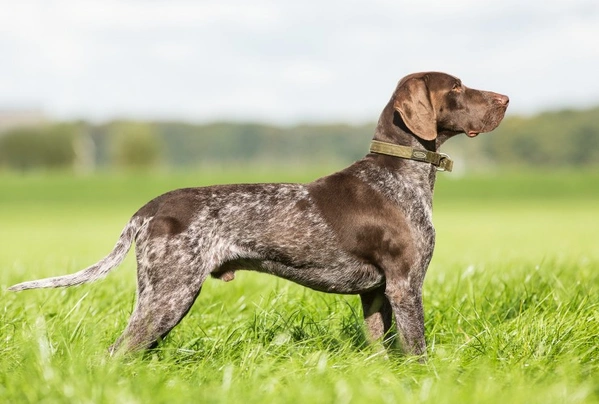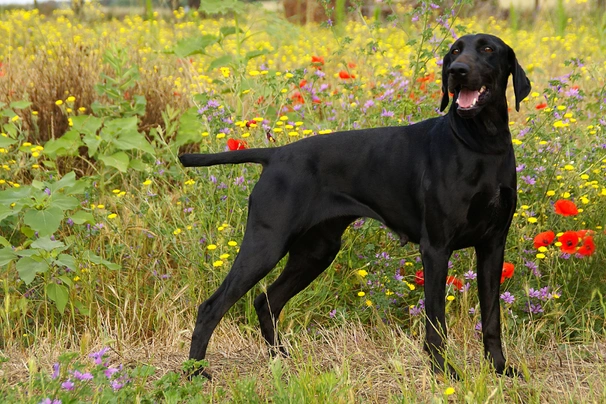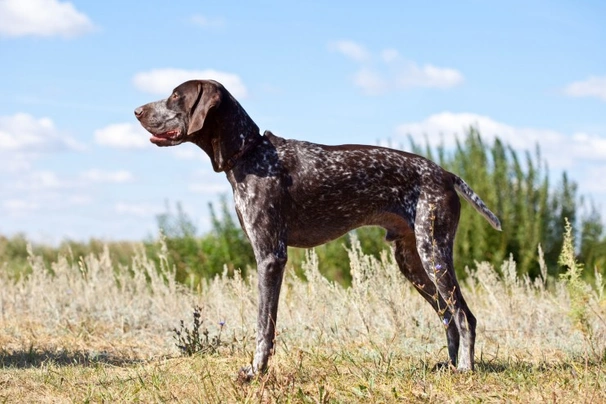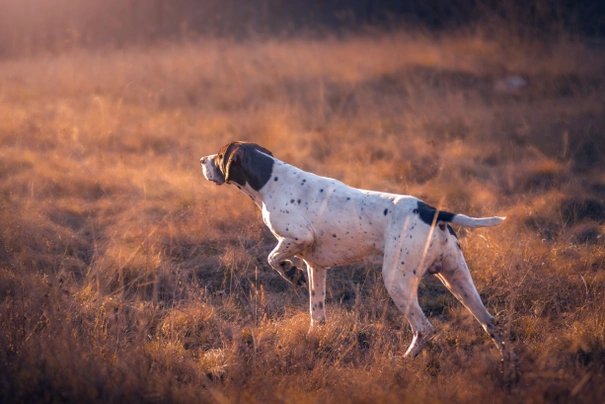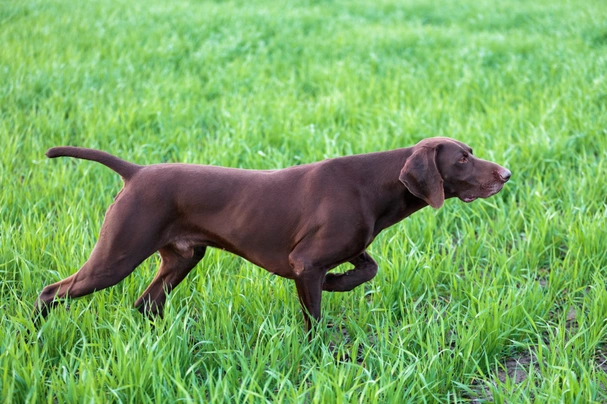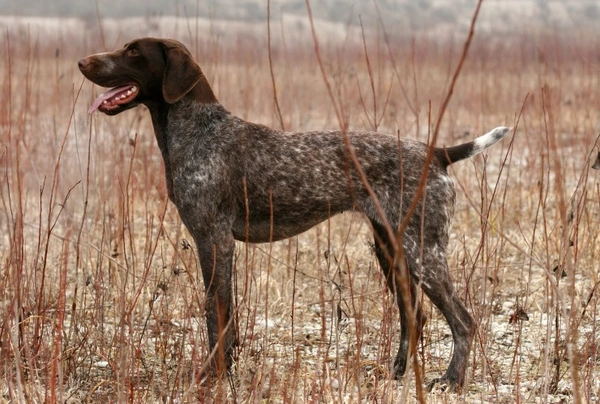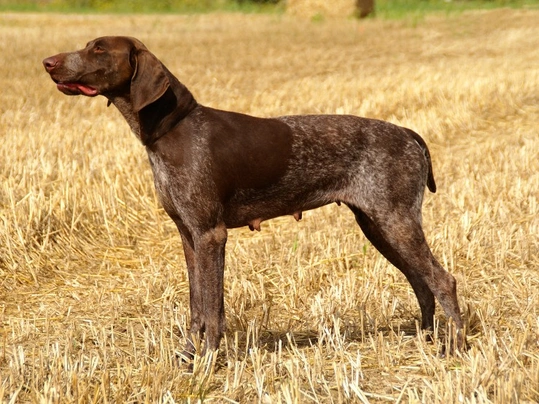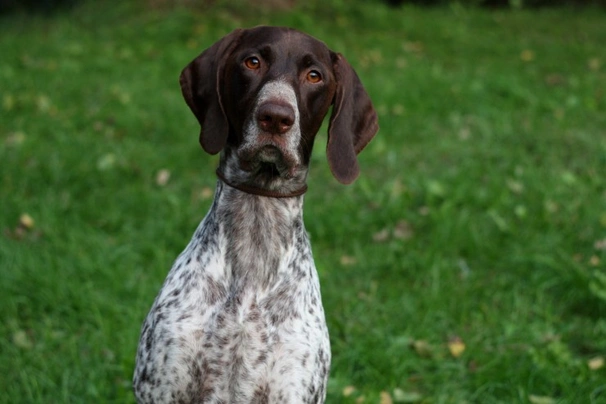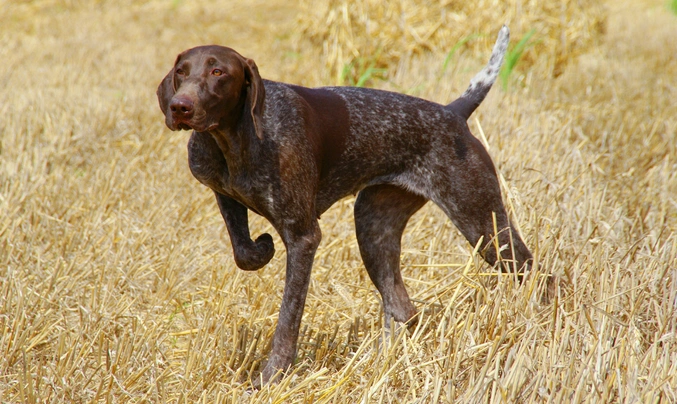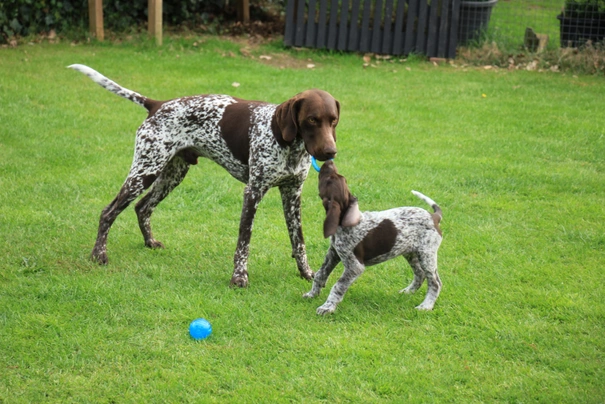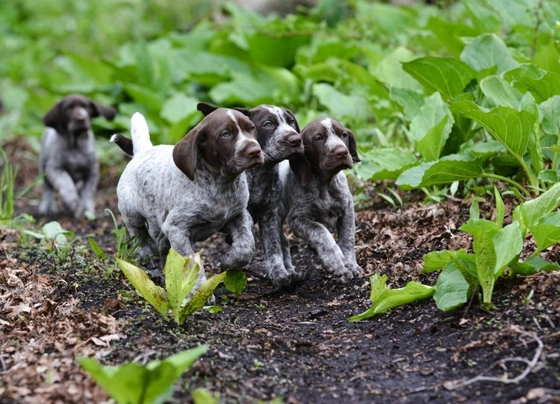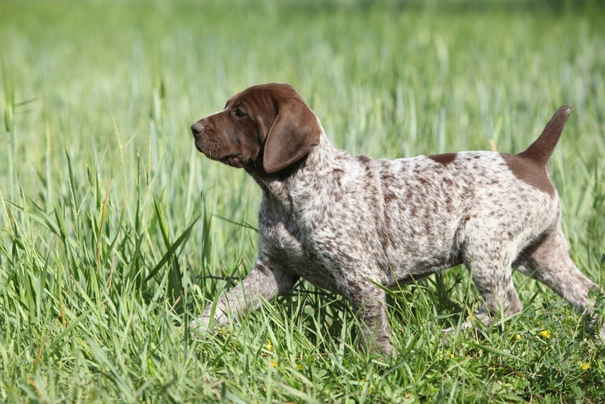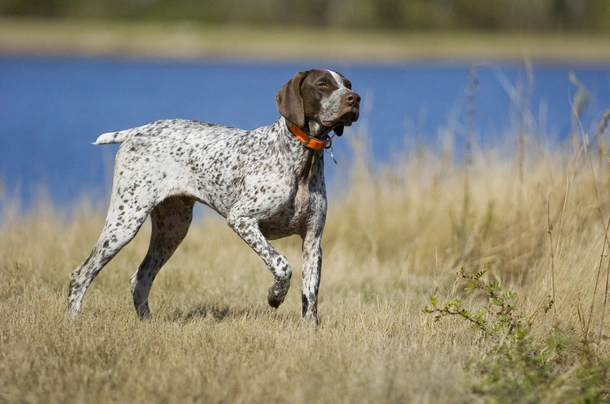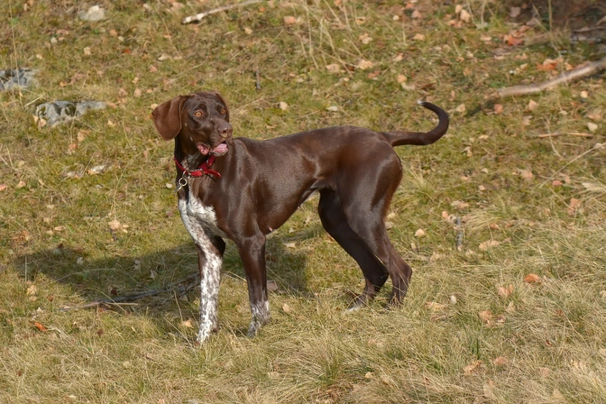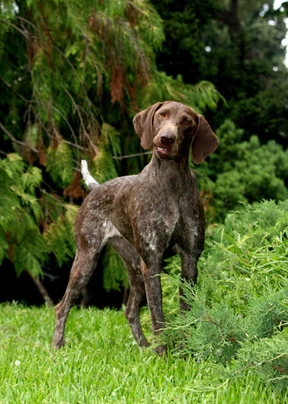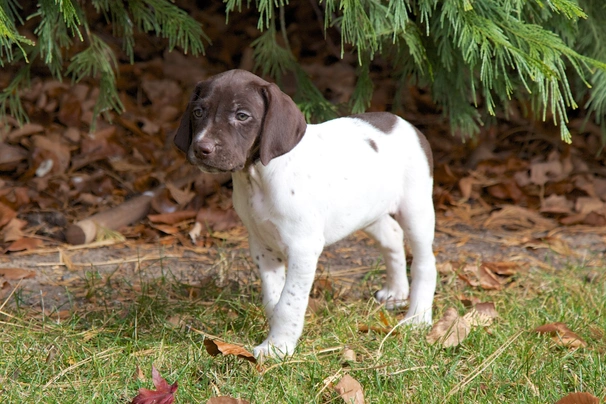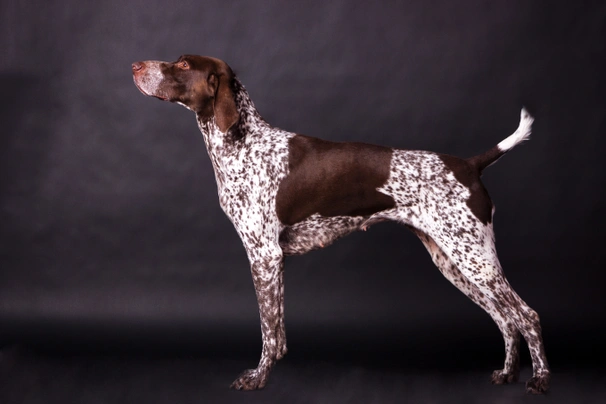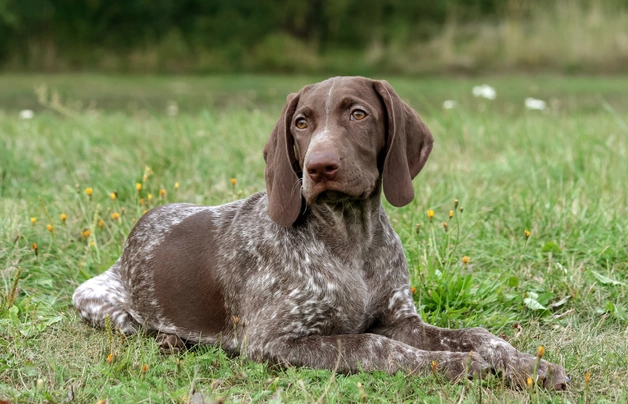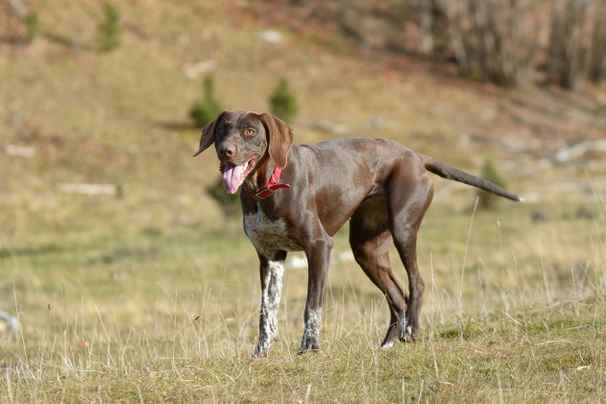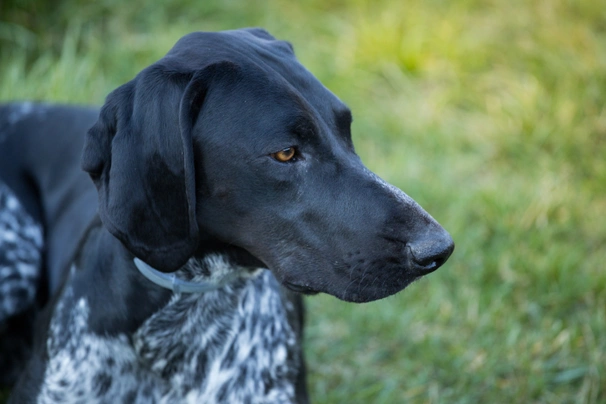German Shorthaired Pointer
Pros
Cons
Introduction of the German Shorthaired Pointer
The German Shorthaired Pointer is among the most popular Hunt Point and Retrieve working dogs to have been imported to the UK since the end of the World War II. They are handsome athletic and dedicated dogs that over the years have also earned themselves a solid reputation for being good companions and family pets. GSP's are athletic large dogs that boast a noble elegant appearance which paired to their well-balanced natures sees them enjoying success both in the field and in the showring too.
History of the German Shorthaired Pointer
The actual origins of the German Shorthaired Pointer remain unclear but it's thought the breed is a descendant of the ancient German Bird Dog and that these smart handsome dogs share a few of the Spanish Pointer’s genetic traits which was a sporting dog introduced to Germany during the 17th century. With this said the GSP probably came about using various pointer breeds as well as a few tracking and hunting dogs which could well include Bloodhounds more especially because there were so many in both Germany and England at the time.
Back in the day Germany was densely forested but with lots of open land too which meant that hunters needed a dog capable of working over different terrains tracking rabbit deer wild boar wolves and grouse. These dogs needed a strong tracking ability and sensitive nose but they also needed to have a lot of stamina and a dog that would "point" to the prey so hunters could retrieve it. The dogs needed to be robust and aggressive enough to cope with larger prey but hunters also wanted the dog to be a companion too. As such hunters set about creating a dog that would meet all these needs.
They continued to improve the breed by introducing other dogs that boasted strong scenting abilities combined with speed so in the 1860's English Pointers were introduced into the mix Prince Albert zu Solms-Braunfeld was a breed enthusiast and he encouraged breeders to develop a hardworking biddable hunting dog rather than choose stud dogs for their looks alone. The first studbook was established in the 1870's but before this time breed records were not kept. It was in 1887 that the German Shorthaired Pointer was first exhibited in the UK but the breed was not a success at the time. The first dog was taken over to the States in 1925 when a breeding programme was established. However World War II had an impact on the breed in that nobody wanted a German hunting dog because of their connection with the "Fatherland".
However breed enthusiasts hid their dogs in order to save them with the best of the breed being sent to Yugoslavia which at the time was behind the Iron Curtain. At the end of the war breeders could not get to their best dogs because of this and as such it was necessary to re-build breed numbers using a very limited gene pool. Today the German Shorthaired Pointer remains one of the most popular hunting dogs around but they have also earned themselves a solid reputation for being wonderful companions and family pets thanks to their kind placid and loyal natures and more especially with people who lead active outdoor lives.
Interesting facts about the breed
- Is the German Shorthaired Pointer a vulnerable breed? No they are now among one of the most popular breeds not only in the UK but elsewhere in the world both as working dogs family pets and companions
- They are one of the most versatile hunt point and retrieve dogs in the world and therefore highly prized by the hunting fraternity
- GSPs were bred to hunt point and retrieve both on water and on land
- GSPs have traditionally had their tails docked a practice that has been going on throughout time. The reason spaniel's tails were docked was to prevent them from being damaged when dogs were flushing out and retrieving game in undergrowth. It was only in 1993 that a law was passed preventing anyone other than a vet from carrying out the procedure but this was further changed when The Animal Health and Welfare Act (Scotland) came into effect in 2006 which invoked a total ban on tail docking unless for medical reasons. In other parts of the UK the Animal Welfare Act came into effect in April 2007 which meant that dog's tails could no longer be docked unless they fell into the category of a specific "working" dog or for medical reasons.
Appearance of the German Shorthaired Pointer
Height at the withers: Males 58 - 64 cm Females 53 - 59 cm
Average weight: Males 25 - 32 kg Females 20 - 27 kg
The German Shorthaired Pointer has a noble look. They are strong and powerful yet athletic always on the alert which are just some of the reasons why they have always been so highly prized as working dogs in the field. They are well-proportioned and boast having nice broad heads. When viewed from the side they have well-defined stops which are enhanced by a dog's charming eyebrows.
Muzzles are moderately long rising slightly from the tip to a dog's forehead a trait that is more pronounced in males than in their female counterparts. They have well developed lips without them being too over hung. Their noses are brown or black depending on the colour of a dog's coat and they have wide open nostrils. Eyes are medium in size and can be various shades of brown to match a dog’s coat colour. GSPs always have an intelligent gentle look about their eyes.
Their ears are set high being broad and hanging close to a dog's head without having a pronounced fold in them. They are rounded at the tips and quite long reaching to the corners of a dog's mouth when they fall forward. The German Shorthaired Pointer has a strong jaw with a perfect scissor bite where their upper teeth neatly overlap their lower ones. Their necks are quite long and well-muscled being slightly arched and thicker at the shoulders than at a dog's nape. Shoulders are muscular and sloping. Their front legs are lean straight and well-muscled without showing too much bone.
The GSP has a very athletic body with a deep chest that's not too wide. Ribs are also deep and very well sprung being nicely let down which adds to a dog’s athletic appearance. They have wide and slightly arched loins and wide long croups with dogs having level backs that gently slop towards the tail. Bellies are nicely tucked up. Their hindquarters are powerful and strong with dogs having broad wide hips that fall away to the tail. Back legs are well muscled and strong with well-developed thighs. Their feet are compact and well-padded with close knit toes and strong dark nails. They have moderately long tails which are thicker at the base before tapering to the tip which dogs carry horizontally or just below the level of their backs.
When it comes to their coat the German Shorthaired Pointer boasts having a short close lying coarse coat with the hair being slightly longer under their tails. The accepted breed colours for Kennel Club registration are as follows:
- Black & White
- Black & White Spotted
- Black & White Spotted & Ticked
- Black & White Ticked
- Liver & White
- Liver & White Spotted
- Liver & White Spotted & Ticked
- Liver & White Ticked
- Liver Ticked
- Solid Black
- Solid Liver
Gait/movement
When a German Shorthaired Pointer moves they do so elegantly with a smooth and light action covering a lot of ground when they do. The faster they move the more they single track with their front legs having a far reach gait and a lot of propulsion from behind.
Faults
The Kennel Club frowns on any sort of exaggeration or departure from the breed standard and would judge any faults on how much they affect the overall health and wellbeing of a GSP as well as their ability to perform and work.
Males should have both testicles fully descended into their scrotums and it is worth noting that dogs can be a little lighter or heavier as well as slightly shorter or taller than stated in the Kennel Club breed standard which is given as a guideline only.
Temperament of the German Shorthaired Pointer
The German Shorthaired Pointer is an intelligent dog and one that likes to be kept busy. They make great family pets for people who lead active outdoor lives and in households where the children are older. They are extremely loyal forming strong ties with their owners and they thrive on being in a home environment just as much as they do when they are working in the field. However because they form such strong ties with their owners they never like to be left on their own for any length of time which is why they are better suited to people who lead active outdoor lives.
They have a tremendous amount of energy which means not only do they need to be given the right amount of mental stimulation but they also need enough daily exercise for them to be truly happy well-rounded and obedient characters. Females tend to show a more dominant side to their natures than their male counterparts which needs to be gently curbed when a dog is still young and before it develops into a real problem.
They are not a good choice for first time owners even though the GSP is so biddable and eager to please because they need to be trained and handled by people who are familiar with their specific needs and who have the time to dedicate to such an active intelligent dog. However anyone wishing to share their home with one of these high energy dogs would need to have the time to commit to their canine companions’ needs. They would not suit anyone who leads a more sedentary quiet life because these dogs thrive on being in the great outdoors as much as they can with their owners.
As previously mentioned because they form such strong bonds with their families they do not like to be left on their own for long periods of time and if they are a GSP could quickly develop a condition known as "separation anxiety" which could lead to dogs becoming neurotic and stressed out which can it very hard to live with them. It's essential for these dogs to be well socialised from a young age so they grow up to be confident outgoing mature dogs. Their socialisation has to include introducing them to lots of new situations noises people other animals and dogs once they have been fully vaccinated.
It's also crucial for their training to start early too and it must be consistent throughout a dog's life so they understand what is expected of them. A German Shorthaired Pointer is never happier than when they know their place in the pack and who they can look to for direction and guidance. If they don't know who is the alpha dog in a household they may quickly take on the role of a dominant dog which can make them harder to handle. It is also worth noting that GSPs are slow to mature which only sees dogs typically grow up when they are around 2 years old.
Are they a good choice for first time owners?
German Shorthaired Pointers are not the best choice for first time owners because they need to be handled and trained by people who are familiar with the breed and their specific needs bearing in mind that GSPs are highly intelligent and active dogs that form extremely strong ties with their owners.
What about prey drive?
GSPs were originally bred to hunt large and small prey and as such they do have a high prey drive. As such care should always be taken when walking a dog off the lead anywhere near wildlife or farm animals just in case a dog decides to chase them. The good news is that a well-bred and nicely trained GSP can always be kept under control when being exercised.
What about playfulness?
GSPs have a playful side to their natures and love to entertain and be entertained bearing in mind that they remain puppy-like right up to when they are around 2 years old because they mature so slowly.
What about adaptability?
German Shorthaired Pointers are not as adaptable as many other breeds and are therefore better suited to people who have secure back gardens that dogs can roam in safely as often as possible.
What about separation anxiety?
GSPs form strong ties with their families and dogs are never very happy when they find themselves left on their own for longer periods of time. They are better suited to people who either work from home or in households where one person stays at home when everyone else is out so they are never alone for any length of time which could see a dog suffering from separation anxiety. This can lead to them being destructive around the home which is a dog's way of relieving any stress they are feeling and a way to keep themselves entertained.
What about excessive barking?
German Shorthaired Pointers are not known to be "barkers" and will typically only bark when they want to get an owner's attention. With this said if a dog is left on their own for too long it could lead to them barking incessantly which is their way of showing how stressed out they are at the situation.
Do German Shorthaired Pointers like water?
German Shorthaired Pointers love swimming and will take to the water whenever they can more especially when the weather is hot which is why care should always be taken when walking a dog off the lead anywhere near more dangerous watercourses just in case a dog decides to leap in and then needs rescuing.
Are German Shorthaired Pointers good watchdogs?
German Shorthaired Pointers were at one time bred to be good watchdogs in their native Germany. However this is not a trait that is very evident in the breed these days but this does not mean a GSP would not be quick off the mark to let an owner know when they are strangers about or when something they don't like is going on in their surroundings.
Intelligence / Trainability of the German Shorthaired Pointer
The German Shorthaired Pointer is a smart dog and a fast learner. The downside to this is they are just as quick to pick up bad habits as they are the good. As such their training has to begin early and it has to be consistent and always fair throughout a dog’s life so they understand what owners expect of them. GSPs are never happier than when they are given something to do which is why they are so amenable to learning new things.
They excel at many canine sports which includes activities like flyball agility obedience and falconry because they thrive on the attention they are given during their training and the one-to-one contact when they are competing with their handlers. The key to successfully training a GSP is to make their training as interesting as possible and to avoid too much repetition. It's also a good idea to keep training sessions that much shorter which helps dogs stay more focussed on what it’s being asked of them bearing in mind that the more intelligent a dog is the faster they get bored. They do not answer well to harsh correction or any sort of heavy handed training methods but they do respond extremely well to positive reinforcement which always brings the best out of these intelligent and quick-witted dogs especially when there are high value rewards involved.
GSP puppies must be well socialised from a young age and they also need to be taught the first commands right from the word go so they understand the ground rules and what owners expect of them. The first commands a puppy should be taught are as follows:
- Come
- Sit
- Stay
- Quiet
- Leave it
- Down
- Bed
Children and other
German Shorthaired Pointers are known to be very good around children. However because of their large size and the fact they can be rather boisterous they are best suited to families where the children are slightly older and who therefore know how to behave around dogs. Any interaction between toddlers and a dog should always be supervised by an adult to make sure playtime does not get too boisterous which could end up with someone being knocked over and hurt albeit by accident. They can be a little "off" with children they don't know so care has to be taken when the kids have friends over.
When dogs have been well socialised from a young enough age they generally get on well with other dogs they meet and if they have grown up with a family cat in a household they usually get on well together. However a GSP would think nothing of chasing off any other cats they encounter because they would see them as fair game. Care has to be taken when they are around any smaller animals and pets because of their high prey drive as such any contact is best avoided.
Health of the German Shorthaired Pointer
The average life expectancy of a German Shorthaired Pointer is between 12 and 14 years when properly cared for and fed an appropriate good quality diet to suit their ages.
The GSP is known to suffer from a few hereditary health issues which are worth knowing about if you are planning share your home with one of these active and good looking dogs. The conditions that seem to affect the breed the most include the following:
- Hip dysplasia - Breeders should have stud dogs hip scored
- Elbow dysplasia - breeders should have stud dogs elbow tested
- Eye diseases
- Epilepsy
- Skin diseases
- Cancer
- von Willebrand's Disease
- Lymphedema
- Bloat - Gastric torsion
More about tail docking
GSPs have traditionally had their tails docked a practice that has been going on throughout time. The reason spaniel's tails were docked was to prevent them from being damaged when dogs were flushing out and retrieving game in undergrowth. It was only in 1993 that a law was passed preventing anyone other than a vet from carrying out the procedure but this was further changed when The Animal Health and Welfare Act (Scotland) came into effect in 2006 which invoked a total ban on tail docking unless for medical reasons. In other parts of the UK the Animal Welfare Act came into effect in April 2007 which meant that dog's tails could no longer be docked unless they fell into the category of a specific "working" dog or for medical reasons.
What about vaccinations?
GSP puppies would have been given their initial vaccinations before being sold but it is up to their new owners to make sure they have their follow-up shots in a timely manner with the vaccination schedule for puppies being as follows:
- 10 -12 weeks old bearing in mind that a puppy would not have full protection straight away but would be fully protected 2 weeks after they have had their second vaccination
There has been a lot of discussion about the need for dogs to have boosters. As such it's best to talk to a vet before making a final decision on whether a dog should continue to have annual vaccinations which are known as boosters.
What about spaying and neutering?
A lot of vets these days recommend waiting until dogs are slightly older before spaying and neutering them which means they are more mature before undergoing the procedures. As such they advise neutering males and spaying females when they are between the ages of 6 to 9 months old. Other vets recommend spaying and neutering dogs when they are 6 months old but never any earlier unless for medical reasons.
What about obesity problems?
Some GSPs can gain weight after they have been spayed or neutered and it's important to keep an eye on a dog's waistline just in case they do. If a dog starts to put on weight it's important to adjust their daily calorie intake and to up the amount of exercise they are given. Older German Shorthaired Pointers too are more prone to gaining weight and again it's essential they be fed and exercised accordingly because obesity can shorten a dog's life by several years. The reason being that it puts a lot of extra strain on a dog's internal organs including the heart.
What about allergies?
GSPs are prone to suffering from allergies bearing in mind that some dogs develop skin diseases. It's important for a dog to see a vet sooner rather than later if one flares up. Allergies can be notoriously hard to clear up and finding the triggers can be challenging. With this said a vet would be able to make a dog with an allergy more comfortable sooner rather than later. The most common triggers for allergies include the following:
- Certain foods
- Airborne pollens
- Dust mites
- Environment
- Flea and tick bites
- Chemicals found in everyday household cleaning products
Participating in health schemes
All responsible German Shorthaired Pointer breeders would ensure that their stud dogs are tested for known hereditary and congenital health issues known to affect the breed by using the following schemes:
What about breed specific breeding restrictions?
It is mandatory for all Kennel Club Assured Breeders to have stud dogs tested using the following scheme and the KC strongly recommends that other breeders also follow suit:
The Kennel Club also strongly advises that all breeders follow the guidelines below:
- Bitches not to produce a litter under two years of age
- Bitches not to produce more than four litters in their lifetime
What about Assured Breeder Requirements?
Apart from the standard breeding restrictions for all Kennel Club registered breeds there are no other breed specific breeding restrictions for the GSP.
Caring for the German Shorthaired Pointer
As with any other breed German Shorthaired Pointers need to be groomed on a regular basis to make sure their coats and skin are kept in top condition bearing in mind that they are known to suffer from certain skin diseases. They also need to be given regular daily exercise to ensure they remain fit and healthy. On top of this dogs need to be fed good quality food that meets all their nutritional needs throughout their lives.
Caring for an German Shorthaired Pointer puppy
GSP puppies are boisterous and full of life which means it's essential for homes and gardens to be puppy-proofed well in advance of their arrival. A responsible breeder would have well socialised their puppies which always leads to more outgoing confident and friendly dogs right from the word go. With this said any puppy is going to feel vulnerable when they leave their mother and littermates which must be taken into account. The longer a puppy can remain with their mother the better although it should never be for too long either.
It's best to arrange to pick puppy up when people in the home are going to be around for the first week or so which is the time needed for a puppy to settle in. Puppy-proofing the home and garden means putting away any tools and other implements that a boisterous puppy might injure themselves on. Electric wires and cables must be put out of their reach because puppies love chewing on things. Toxic plants should be removed from flowerbeds and the home too.
Puppies need to sleep a lot to grow and develop as they should which means setting up a quiet area that's not too out of the way means they can retreat to it when they want to nap and it's important not to disturb them when they are sleeping. It's also a good idea to keep "playtime" nice and calm inside the house and to have a more active "playtime" outside in the garden which means puppies quickly learn to be less boisterous when they are inside.
The documentation a breeder provides for a puppy must have all the details of their worming date and the product used as well as the information relating to their microchip. It is essential for puppies to be wormed again keeping to a schedule which is as follows:
- Puppies should be wormed at 6 months old
- They need to be wormed again when they are 8 months old
- Puppies should be wormed when they are 10 months old
- They need to be wormed when they are 12 months old
Things you'll need for your puppy
There are certain items that new owners need to already have in the home prior to bringing a new puppy home. It's often a good idea to restrict how much space a puppy plays in more especially when you can't keep an eye on what they get up to bearing in mind that puppies are often quite boisterous which means investing in puppy gates or a large enough playpen that allows a GSP puppy the room to express themselves while keeping them safe too. The items needed are therefore as follows:
- Good quality puppy or baby gates to fit on doors
- A good well-made playpen that's large enough for a puppy to play in so they can really express themselves as puppies like to do
- Lots of well-made toys which must include good quality chews suitable for puppies to gnaw on bearing in mind that a puppy will start teething anything from when they are 3 to 8 months old
- Good quality feed and water bowls which ideally should be ceramic rather than plastic or metal
- A grooming glove
- A slicker brush or soft bristle brush
- Dog specific toothpaste and a toothbrush
- Scissors with rounded ends
- Nail clippers
- Puppy shampoo and conditioner which must be specifically formulated for use on dogs
- A well-made dog collar or harness
- A couple of strong dog leads
- A well-made dog bed that's not too small or too big
- A well-made dog crate for use in the car and in the home that's large enough for a puppy to move around in
- Baby blankets to put in your puppy's crate and in their beds for when they want to nap or go to sleep at night
Keeping the noise down
All puppies are sensitive to noise including German Shorthaired Pointer puppies. It's important to keep the noise levels down when a new puppy arrives in the home. TVs and music should not be played too loud which could end up stressing a small puppy out.
Keeping vet appointments
As previously mentioned GSP puppies would have been given their first vaccinations by the breeders but they must have their follow up shots which is up to their new owners to organise. The vaccination schedule for puppies is as follows:
- 10 -12 weeks old bearing in mind that a puppy would not have full protection straight away but would only be fully protected 2 weeks after they have had their second vaccination
When it comes to boosters it's best to discuss these with a vet because there is a lot of debate about whether a dog really needs them after a certain time. However if a dog ever needed to go into kennels their vaccinations would need to be
What about older German Shorthaired Pointers when they reach their senior years?
Older GSPs need lots of special care because as they reach their golden years they are more at risk of developing certain health concerns. Physically a German Shorthaired Pointer will start to have a greying muzzle but there will be other noticeable changes too which includes the following:
- Coats become coarser
- A loss of muscle tone
- GSPs can either become overweight or underweight
- They have reduced strength and stamina
- Older dogs have difficulty regulating their body temperature
- They often develop arthritis
- Immune systems do not work as efficiently as they once did which means dogs are more susceptible to infections
Older dogs change mentally too which means their response time tends to be slower as such they develop the following:
- They respond less to external stimuli due to impaired vision or hearing
- They tend to be a little pickier about their food
- They have a lower pain threshold
- Become intolerant of any change
- Often an older dog can feel disorientated
Living with a GSP in their golden years means taking on a few more responsibilities but these are easily managed and should include taking a look at their diet the amount of exercise they are given how often their dog beds need changing and keeping an eye on the condition of their teeth.
Older German Shorthaired Pointers need to be fed a good quality diet that meets their needs at this stage of their lives all the while keeping a close eye on a dog's weight. A rough feeding guide for older GSPs is as follows bearing in mind they should be fed highly digestible food that does not contain any additives:
- Protein content should be anything from 14 – 21%
- Fat content should be less than 10%
- Fibre content should be less than 4%
- Calcium content should be 0.5 – 0.8%
- Phosphorous content should be 0.4 – 0.7%
- Sodium content should be 0.2 – 0.4%
Older GSPs don't need to be given the same amount of daily exercise as a younger dog but they still need the right amount of physical activity to maintain muscle tone and to prevent a dog from putting on too much weight. All dogs need access to fresh clean water and this is especially true of older dogs when they reach their golden years because they are more at risk of developing kidney disorders.
Grooming of the German Shorthaired Pointer
The German Shorthaired Pointer as their name suggests boasts having a short close lying coat and as such they are low maintenance on the grooming front. A weekly brush and wipe over with a chamois leather is all it takes to keep their coats shiny and in good condition.
They shed steadily throughout the year only more so during the Spring and then again in the Autumn when more frequent grooming is usually necessary to stay on top of things and to remove dead and shed hair from a dog's coat. It's also important to check a dog's ears on a regular basis and to clean them when necessary. If too much wax is allowed to build up it can lead to a painful infection which can be hard to clear up. In short prevention is often easier than cure with ear infections.
Exercise of the German Shorthaired Pointer
The German Shorthaired Pointer is a high energy intelligent dog and as such they need to be given the right amount of daily exercise and mental stimulation for them to be truly happy well-rounded dogs. They need at least 2 hour's exercise a day with as much off the lead time as possible but only in a safe and secure environment. If they are not given the right amount of mental stimulation and exercise every day a GSP would quickly get bored and could even begin to show some destructive behaviours around the home which is their way of relieving any stress they are feeling and not necessarily because they are being naughty.
A shorter walk in the morning would be fine but a longer more interesting one in the afternoon is a must with as much off the lead time as possible. These dogs also like to be able to roam around a back garden so they can really let off steam. However the fencing has to be extremely secure to keep these active high-energy dogs in because if they find a weakness in the fence they will soon escape and could get into all sorts of trouble.
With this said GSP puppies should not be over exercised because their joints and bones are still growing. This includes not letting a dog jump up and down from furniture or going up or down the stairs. Too much pressure placed on their joints and spines at an early age could result in a dog developing serious problems later in their lives.
Feeding of the German Shorthaired Pointer
If you get a German Shorthaired Pointer puppy from a breeder they would give you a feeding schedule and it's important to stick to the same routine feeding the same puppy food to avoid any tummy upsets. You can change a puppy's diet but this needs to be done very gradually always making sure they don't develop any digestive upsets and if they do it's best to put them back on their original diet and to discuss things with the vet before attempting to change it again.
Older dogs are not known to be fussy eaters but this does not mean they can be given a lower quality diet. It's best to feed a mature dog twice a day once in the morning and then again in the evening making sure it's good quality food that meets all their nutritional requirements. It's also important that dogs be given the right amount of exercise so they burn off any excess calories or they might gain too much weight which can lead to all sorts of health issues. Obesity can shorten a dog's life by several years so it's important to keep an eye on their waistline from the word go.
Because GSPs are known to suffer from bloat it is really important for them to be fed twice a day instead of giving a dog one larger meal a day. It's also a good idea to invest in a stand for their feed bowls which makes it easier for dogs to eat comfortably without having to stretch their necks down to reach their food. Dogs should never be exercised just before or just after they have eaten either because this puts them more at risk of suffering from gastric torsion.
Feeding guide for a German Shorthaired Pointer puppy
Puppies need to be fed a highly nutritious good quality diet for them to develop and grow as they should. As a rough guide a GSP puppy can be fed the following amounts every day making sure their meals are evenly spread out throughout the day and it's best to feed them 3 or 4 times a day:
- 2 months old - 264g to 286g depending on puppy's build
- 3 months old - 327g to 365g depending on puppy's build
- 4 months old - 354g to 400g depending on puppy's build
- 5 months old - 381g to 454g depending on puppy's build
- 6 months old - 405g to 505g depending on puppy's build
- 7 months old - 403g to 506g depending on puppy's build
- 8 months old - 374g to 471g depending on puppy's build
- 9 months old - 349g to 440g depending on puppy's build
- 10 months old - 318g to 402g depending on puppy's build
- 11 months old - 290g to 365g depending on puppy's build
- 12 months old - 288g to 363g depending on puppy's build
- 13 months old - 286g to 360g depending on puppy's build
- 14 months old - 286g to 357g depending on puppy's build
Once a puppy is 15 months old they can be fed adult dog food.
Feeding guide for an adult German Shorthaired Pointer
Once fully mature an adult GSP must be fed a good quality diet to ensure their continued good health. As a rough guide an adult German Shorthaired Pointer can be fed the following amounts every day:
- Dogs weighing 20 kg can be fed 276 g to 363g depending on activity
- Dogs weighing 25 kg can be fed 307g to 404g depending on activity
- Dogs weighing 27 kg can be fed 322g to 424g depending on activity
- Dogs weighing 32 kg can be fed 366g to 482g depending on activity
German Shorthaired Pointer price
If you are looking to buy a German Shorthaired Pointer you would need to pay anything from £650 to over £800 for a well-bred pedigree puppy. The cost of insuring a male 3-year-old GSP in northern England would be £25.32 a month for basic cover but for a lifetime policy this would set you back £60.21 a month (quote as of November 2017). When insurance companies calculate a pet's premium they factor in several things which includes where you live in the UK a dog's age and whether or not they have been neutered or spayed among other things.
When it comes to food costs you need to buy the best quality food whether wet or dry making sure it suits the different stages of a dog’s life. This would set you back between £40 - £50 a month. On top of all of this you need to factor in veterinary costs if you want to share your home with a German Shorthaired Pointer and this includes their initial vaccinations their annual boosters the cost of neutering or spaying a dog when the time is right and their yearly health checks all of which quickly adds up to over £1000 a year.
As a rough guide the average cost to keep and care for a German Shorthaired Pointer would be between £70 to £110 a month depending on the level of insurance cover you opt to buy for your dog but this does not include the initial cost of buying a well-bred pedigree Kennel Club registered puppy.
Buying advice
When visiting and buying any puppy or dog there are many important things to consider and questions to ask of the breeder/seller. You can read our generic puppy/dog advice here which includes making sure you see the puppy with its mother and to verify that the dog has been wormed and microchipped.
GSPs are an extremely popular breed both in the UK and elsewhere in the world which means that well-bred puppies command a lot of money. As such with German Shorthaired Pointers there is specific advice questions and protocols to follow when buying a puppy which are as follows:
- Beware of online scams and how to avoid them. You may see online and other adverts by scammers showing images of beautiful German Shorthaired Pointerpuppies for sale at very low prices. However the sellers ask buyers for money up front before agreeing to deliver a puppy to a new home. Potential buyers should never buy a puppy unseen and should never pay a deposit or any other money online to a seller. You should always visit the pet at the sellers home to confirm they are genuine and make a note of their address.
- As previously touched upon German Shorthaired Pointers are among the most popular breeds in the UK. As such there are many amateur breeders/people who breed from X far too often so they can make a quick profit without caring for the welfare of the puppies their dam or the breed in general. Under Kennel Club rules a dam can only produce 4 litters and she must be between a certain age to do so. Anyone wishing to buy a X puppy should think very carefully about who they purchase their puppy from and should always ask to see the relevant paperwork pertaining to a puppy's lineage their vaccinations and their microchipping.
- GSPs have traditionally had their tails docked a practice that has been going on throughout time. The reason spaniel's tails were docked was to prevent them from being damaged when dogs were flushing out and retrieving game in undergrowth. It was only in 1993 that a law was passed preventing anyone other than a vet from carrying out the procedure but this was further changed when The Animal Health and Welfare Act (Scotland) came into effect in 2006 which invoked a total ban on tail docking unless for medical reasons. In other parts of the UK the Animal Welfare Act came into effect in April 2007 which meant that dog's tails could no longer be docked unless they fell into the category of a specific "working" dog or for medical reasons.
